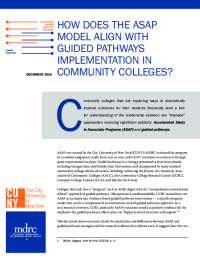How Does the ASAP Model Align with Guided Pathways Implementation in Community Colleges?

Community colleges that are exploring ways to dramatically improve persistence, completion, and transfer outcomes for their students frequently ask about the relationship between two highly touted “branded” approaches: Accelerated Study in Associate Programs (ASAP) and guided pathways. ASAP was created by the City University of New York (CUNY) to serve low-income students enrolling full time and has been found to be highly effective as evaluated by both MDRC and CUNY. Guided pathways is a framework for higher education reform championed by many community college reform advocates; it emphasizes higher levels of structure and support and early entry into well-defined pathways with clear road maps to completion.
This brief draws out the similarities and differences between ASAP and guided pathways and suggests how they might be aligned in community colleges. ASAP is a specific program model with required components; its positive impact on student outcomes has been proven. Guided pathways is a broad approach to institutional reform based on a distillation of several decades of research, but the framework is relatively new and has not been evaluated. Rather, guided pathways provides a set of principles and practices that a college can embrace as a map for institution-wide redesign of basic procedures and policies. This brief highlights the problem definitions motivating ASAP and guided pathways and their respective theories of change, summarizes the evidence for both initiatives, and notes the incremental costs of each approach. Key elements are compared: For example, ASAP includes a last-dollar scholarship because of evidence that unmet financial need is a serious obstacle to success for low-income students; guided pathways is not explicit about financial aid solutions. Guided pathways advocates emphasize the need for revisions in curriculum and instruction, arguing that structural changes alone are insufficient to motivate student success; ASAP focuses primarily on noninstructional changes.
There is clear compatibility between ASAP and guided pathways innovations. It should be possible to integrate the two in a community college that is looking to improve its structure and support for students. Reconciling and integrating ASAP and guided pathways is a fruitful area for further research, design, and implementation activity.







